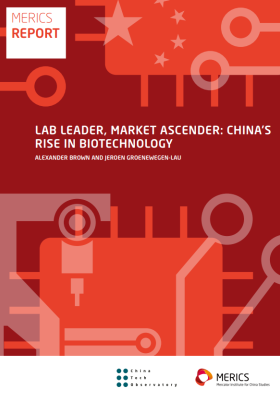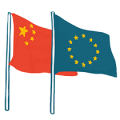

MERICS Forum: How can the EU navigate China’s rare earths export controls
Beijing’s expanding export controls and practice of leveraging other actors’ dependencies pose a critical challenge to EU industry and could hinder efforts to strengthen its defense sector. China’s Ministry of Commerce announced the tightening of rare earths licensing in October, and the expansion of this policy to cover technologies used in rare earths processing. This signals that Beijing intends to restrict the ways in which the EU could mitigate its dependence. A joint G7 response is taking shape, but the unpredictability of US President Donald Trump won’t make Europe’s work any easier. The EU needs solutions both to address immediate shocks and to limit long-term dependence. Failure to act would be immensely costly and create a strategic liability.
In this edition of MERICS Forum, Grzegorz Stec, Head of MERICS’ Brussels Office and Senior Analyst, asked several experts:
How can the EU and its member states navigate China’s rare earths export restrictions?
Jens Eskelund
President of the European Union Chamber of Commerce in China

As a short-to-medium-term solution for eliminating bottlenecks and ensuring the stability of global rare earth supply chains, the European Union (EU) should focus on negotiating a whitelist or a general license scheme with China. This would allow exporters to use one license for multiple shipments of identical components for the same application and the same end users, valid for a set period – ideally three years. The Chamber sees some willingness on the Chinese side to move in this direction, but details still need to be agreed.
As a medium-to-long-term solution, the EU should continue developing its own capabilities – in the mining and refining of rare earth elements (REEs), as well as the development of technologies that can mitigate the environmental impact of such activities – and partner with other markets to diversify the sourcing of REEs. Simultaneously, the EU should also scale up recycling of REEs and promote innovation aimed at reducing their use. The EU’s strategy could also involve engaging with the Chinese authorities to negotiate ways for Chinese companies with proven expertise in the mining and refining of REEs to help build up the EU’s capacity in these areas. This could strengthen the EU-China partnership while also reducing China’s motivation to introduce further restrictions that would be detrimental to EU interests.
Finally, the EU should assess its vulnerabilities to the extraterritorial application of China’s export controls and work to reduce this exposure while devising appropriate responses. While it is unclear how China would do so, now that this possibility has been introduced, it could be taken as a statement of intent that China wants to move towards establishing full control over the global supply chains of rare earth elements and related goods.
Alicia García Herrero
Senior Research Fellow at Bruegel

China's latest export chokehold on rare earth elements – to be expanded to 12 critical minerals from November 1 – strikes at the heart of global supply chains. While directed at the US in retaliation for its recent measures to further strike China with export controls, European companies are bound to be hit as well. Export licenses will be needed for any import of rare earth magnets but also for the use of technology behind rare earth products or even the expertise of Chinese technicians dealing with these. A number of sectors will be particularly affected, such as electric vehicles, but also semiconductor fabs and, importantly, Europe’s nascent military industry. China's 90 percent share of global rare earth processing points to China’s weaponization of a monopoly position.
Geopolitically, this mirrors the curbs on US chips but flips the script, giving China the upper hand, especially against Europe, as no strategy is fully ready to counteract this threat. The 2024 Critical Raw Materials Act offers a path for the EU, by aiming to diversify the sourcing of rare earths from like-minded countries like Australia, but the timeline for such plans is simply too long. Meanwhile, the EU will need to brace for pressure from China in exchange for softening these export controls. The most obvious one is lifting Europe’s tariffs on Chinese electric vehicles and, potentially freezing the many EU investigations that are against China’s interests. The reality is that the quicker the EU gives in, the faster China will ask for more.
Joris Teer
Research Analyst for Economic Security and Technology at the EU Institute for Security Studies (EUISS)

The EU should dismantle Beijing’s critical raw materials weaponization as soon as possible. This requires moving beyond the failure-prone practice of supporting European industrial champions (or “picking winners”). Price floors, state investment, guaranteed offtake agreements, visa liberalization for international STEM-talent, and other support is necessary to kickstart the EU’s 60 Strategic Projects. However, European and partner country unilateralism could incentivize subsidy races and protectionist measures between them.
A more sustainable solution is recreating international market dynamics in a European and partner coalition. The goal: jointly correcting – through local and partner content requirements in public procurement and joint tariffs against Chinese material producers – for China’s below-market price advantages. Creating an ex-China market reintroduces corrective free market mechanisms and leverages the principle of comparative advantage within the coalition. These protections also shield European industries against Beijing reversing course and again flooding material markets to kill off European nascent diversification projects.
Low hanging fruit: Fund production of minor metals, like gallium, that European companies still produced a decade ago to achieve a low-cost “proof of concept.” Co-invest with the Japan Organization for Metals and Energy Security (JOGMEC) in material production. This will grant European industry early access to JOGMEC’s more advanced diversification projects. Leverage defense spending to secure material supply for arms production and other critical sectors by making mining, refining, and magnet-making explicitly eligible under NATO’s 1.5 percent target. Encourage industry to stockpile materials but avoid stockpiling obligation for materials that China already limited supply of (e.g., heavy rare earths). This will only aggravate existing shortages. Find the full action plan here.”
Francesca Ghiretti
Director of the RAND Europe China Initiative (RECI)
Research Leader at RAND Europe

China’s decision to tighten export controls on rare earth elements has exposed a critical vulnerability in the EU’s economic security approach. While Brussels has long relied on its market access as a deterrent, embodied in instruments like the Anti-Coercion Instrument (ACI), Beijing’s move underscores the asymmetry between supply and demand restrictions. Export controls, unlike tariffs, bite immediately. When key inputs vanish, factories halt, revenues evaporate, and strategic sectors stall.
The EU’s approach, rooted in liberal market principles, assumes that demand-side tools can shape global behaviour. Yet, as of April 2025, China’s REE restrictions have shown that supply-side coercion delivers faster, sharper consequences. Europe’s dependence on external suppliers, coupled with limited stockpiling and diversification, leaves it exposed. Meanwhile, tariffs take time to inflict pain and often hurt the imposer in the process.
This imbalance raises uncomfortable questions. Can the EU wield supply-side leverage of its own? If not, it must rethink how to survive in a world where economic statecraft is increasingly transactional. A doctrine that accounts for this asymmetry is overdue.
In the short term, Europe must make its demand-side tools more potent. That means acting collectively, not just within the bloc but with like-minded partners beyond it. Economic security, in an era of weaponized interdependence, cannot be achieved in isolation.
Jakub Jakóbowski
Deputy Director of the Centre for Eastern Studies (OSW) and Head of the China Department

There are two layers to China’s strategic intent behind the latest sweeping export controls. The first is the obvious one: coercion. By calibrating the pace and scope of export-license approvals, Beijing’s bureaucracy can hold EU civilian value chains in check – and then ask for political concessions. If that is the game, the EU is not without tools. The Anti-Coercion Instrument (ACI) provides a basis for pushback, including by identifying – and if necessary, leveraging – China’s own dependencies. The aim should be de-escalation, as with Brussels’ handling of transatlantic tariff saber-rattling this spring. But credible deterrence must be established now; China has a much longer list of chokepoints it can use to bring Europe to heel.
There is also a deeper motive in these nominally dual-use bans, one that is often hiding in plain sight. Beijing seeks to slow the rearmament of what it sees as a US-led alliance system, including Europe’s NATO members. China has been explicit about its hostility to NATO and its fear that, once Russia is defeated, the West will turn to confronting China. However implausible that may sound in parts of Europe, it is clearly Beijing’s perception. Denying Europe critical dual-use raw materials – while expanding equivalent supplies to Russia – fits that logic. Europe should then not expect a rollback of critical dual-use supplies restrictions. It should instead double down on the Critical Raw Materials Act, plug it firmly into defense supply chains and diversify – before it is too late.
Rebecca Arcesati
Lead Analyst, Science, Technology and Innovation program at MERICS

If Europeans think they are just casualties of the US-China tech and trade war, they are wrong. China now holds the keys to global supply and trade of 12 out of 17 rare earth elements (REEs), permanent magnets, as well as critical equipment, technology and human know-how required throughout related value chains. It also asserts jurisdiction over any product, made anywhere on the planet, if it contains even a minuscule trace of China-origin REEs or was produced using controlled Chinese technology. This is an unprecedented escalation, with concrete impacts on European industries from defense to semiconductors.
The immediate priority for the EU and capitals should be elevating the issue to the economic and national security emergency that it is. While Beijing is unlikely to allow exports or re-exports to defense end-users, or for defense production, the European Commission should push China’s commerce ministry to commit to a presumption of approval for civilian licenses. This should include licensing of REE and magnet exports aimed at semiconductor tooling and fabrication, among other industrial applications. Beijing should also be pushed to walk back specific, overly stringent restrictions, such as those around stockpiling.
Member states should be prepared to activate the Anti-Coercion Instrument (ACI) and, should initial negotiations not bear fruit, adopt countermeasures. To get to this political decision, a candid discussion of the EU’s collective leverage and pain tolerance will be required. For example, Beijing may demand concessions in the form of a relaxation of export controls, such as the Dutch controls on lithography. The only way forward, then, is for the EU to credibly signal an ability and willingness to impose costs on China, for example through readiness to limit market access.

This MERICS Forum is part of the “Dealing with a Resurgent China” (DWARC) project, which has received funding from the European Union’s Horizon Europe research and innovation programme under grant agreement number 101061700.
Views and opinions expressed are however those of the author(s) only and do not necessarily reflect those of the European Union. Neither the European Union nor the granting authority can be held responsible for them.
